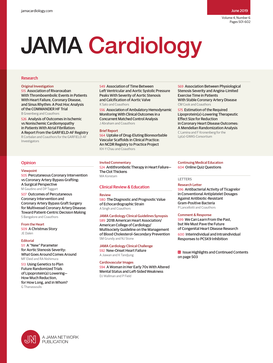Performance of the American Heart Association's PREVENT Equations Among Disaggregated Racial and Ethnic Subgroups.
IF 14.1
1区 医学
Q1 CARDIAC & CARDIOVASCULAR SYSTEMS
引用次数: 0
Abstract
Importance In the original validation, the Predicting Risk of Cardiovascular Disease (CVD) Events (PREVENT) equations demonstrated good discrimination and calibration among racial and ethnic groups, but the model performance among Asian and Hispanic disaggregated subgroups has not been previously described. Objective To assess the performance of the PREVENT equations by race and ethnicity, including disaggregated Asian and Hispanic subgroups. Design, Setting, and Participants This was an electronic health record-based retrospective cohort study of primary care patients aged 30 to 79 years across Sutter Health, a large integrated health system in Northern California, from January 2010 to September 2023. Patients who had at least 2 primary care visits during the study period were eligible for the study (1 484 582). Those outside of the study age range, with prior CVD events in the washout period, missing key predictors, or having at least 1 predictor out of the allowed normal range for the American Heart Association's PREVENT equations, were excluded, leaving a study population of 361 778. Exposure Eligible patients had complete baseline data required for the PREVENT equations, including non-high-density lipoprotein cholesterol, high-density lipoprotein cholesterol, systolic blood pressure, body mass index, estimated glomerular filtration rate (or creatinine), diabetes, and current smoking status, and were free from CVD at baseline. Main Outcomes and Measures The primary outcomes were CVD events, identified using International Classification of Diseases, Ninth and Tenth Revisions, codes described in the PREVENT derivation. Results Among 361 778 patients who met the inclusion criteria, mean (SD) age was 54.6 (12.2) years; 191 151 (53%) were female; and 81 424 (22%) were non-Hispanic Asian and 40 897 (11%) were Hispanic. Over a mean (SD) follow-up of 8.1 (3.2) years, there were 22 648 (6.3%) CVD events. The C statistic for total CVD was 0.83 (95% CI, 0.82-0.84) for the Asian population and 0.80 (95% CI, 0.79-0.81) for the Hispanic population. The calibration slopes were 0.84 (95% CI, 0.78-0.90) and 1.02 (95% CI, 0.94-1.10) for Asian and Hispanic patients, respectively. Within the Asian population, C statistics for total CVD among disaggregated Asian subgroups ranged from 0.79 (95% CI, 0.77-0.81) in Filipino patients to 0.85 (95% CI, 0.83-0.87) in Asian Indian patients. The calibration slope for total CVD was less than 1 for all Asian subgroups except Asian Indian. Among disaggregated Hispanic subgroups, the C statistics were similar and between 0.80 and 0.82 for total CVD, and the calibration slope for total CVD included 1 for all subgroups. There were small differences in the performance of atherosclerotic CVD and heart failure PREVENT equations among racial and ethnic groups and subgroups. Conclusions and Relevance The PREVENT equations appropriately predicted risk in contemporary diverse Asian and Hispanic subgroups with modest variation in performance across disaggregated subgroups.美国心脏协会的预防方程式在分类种族和民族亚组中的表现。
在最初的验证中,预测心血管疾病(CVD)事件风险(prevention)方程在种族和民族群体中表现出良好的区分和校准,但模型在亚洲和西班牙裔分类亚组中的表现此前尚未被描述。目的按种族和民族(包括亚洲和西班牙裔亚组)评估预防方程的性能。设计、环境和参与者:这是一项基于电子健康记录的回顾性队列研究,研究对象是2010年1月至2023年9月期间来自北加州大型综合卫生系统Sutter health的30至79岁初级保健患者。在研究期间至少有2次初级保健就诊的患者符合研究条件(1 484 582)。排除那些在研究年龄范围之外,在洗脱期有心血管疾病事件,缺少关键预测因子,或至少有一个预测因子超出美国心脏协会预防方程允许的正常范围的人,使研究人群为361 778。暴露条件:符合条件的患者具有预防方程所需的完整基线数据,包括非高密度脂蛋白胆固醇、高密度脂蛋白胆固醇、收缩压、体重指数、估计肾小球滤过率(或肌酐)、糖尿病和当前吸烟状况,基线时无心血管疾病。主要结局和措施主要结局是心血管疾病事件,使用国际疾病分类第九版和第十版确定,代码在prevention衍生中描述。结果361 778例符合纳入标准的患者中,平均(SD)年龄为54.6(12.2)岁;191例 151例(53%)为女性;81 424例(22%)为非西班牙裔亚裔,40 897例(11%)为西班牙裔。在平均(SD) 8.1(3.2)年的随访中,有22 648(6.3%)例CVD事件。亚洲人群总CVD的C统计值为0.83 (95% CI, 0.82-0.84),西班牙人群为0.80 (95% CI, 0.79-0.81)。亚裔和西班牙裔患者的校准斜率分别为0.84 (95% CI, 0.78-0.90)和1.02 (95% CI, 0.94-1.10)。在亚洲人群中,亚洲亚组总CVD的C统计值从菲律宾患者的0.79 (95% CI, 0.77-0.81)到亚洲印度患者的0.85 (95% CI, 0.83-0.87)不等。除亚洲印度人外,所有亚洲亚组的总CVD校准斜率均小于1。在西班牙裔亚组中,总CVD的C统计量相似,在0.80 ~ 0.82之间,所有亚组的总CVD校准斜率均为1。在不同种族和亚组之间,动脉粥样硬化性心血管疾病和心力衰竭预防方程的表现存在微小差异。结论和相关性:prevention方程恰当地预测了当代不同亚洲和西班牙亚组的风险,在不同亚组的表现上有适度的变化。
本文章由计算机程序翻译,如有差异,请以英文原文为准。
求助全文
约1分钟内获得全文
求助全文
来源期刊

JAMA cardiology
Medicine-Cardiology and Cardiovascular Medicine
CiteScore
45.80
自引率
1.70%
发文量
264
期刊介绍:
JAMA Cardiology, an international peer-reviewed journal, serves as the premier publication for clinical investigators, clinicians, and trainees in cardiovascular medicine worldwide. As a member of the JAMA Network, it aligns with a consortium of peer-reviewed general medical and specialty publications.
Published online weekly, every Wednesday, and in 12 print/online issues annually, JAMA Cardiology attracts over 4.3 million annual article views and downloads. Research articles become freely accessible online 12 months post-publication without any author fees. Moreover, the online version is readily accessible to institutions in developing countries through the World Health Organization's HINARI program.
Positioned at the intersection of clinical investigation, actionable clinical science, and clinical practice, JAMA Cardiology prioritizes traditional and evolving cardiovascular medicine, alongside evidence-based health policy. It places particular emphasis on health equity, especially when grounded in original science, as a top editorial priority.
 求助内容:
求助内容: 应助结果提醒方式:
应助结果提醒方式:


